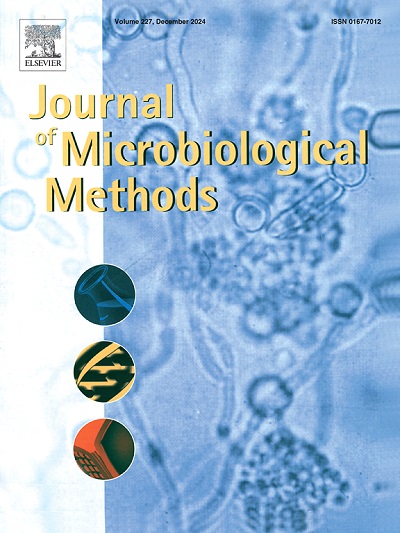为体外研究收集根管生物膜的优化方案。
IF 1.9
4区 生物学
Q4 BIOCHEMICAL RESEARCH METHODS
引用次数: 0
摘要
牙髓再治疗通常是由多种因素造成的,其中包括根管系统(RCS)中微生物的持续存在。它们在生物膜中的复杂组织结构增加了致病的可能性,因此需要新的消毒策略。本研究旨在规范从根管系统收集生物膜的体外新方案。研究使用了 34 颗牛门牙,分为两个实验组,每组有两个收集步骤:(a)生物膜收集方案和(b)吸水纸点方案。每组选取 12 个标本进行菌落形成单位(CFU)计数,同时准备 8 个标本进行扫描电子显微镜(SEM)检查。另外两个标本作为消毒对照,以确保实验不受污染。冠状区被移除并标准化为 15 毫米。用 ProTaper 制备至 F5 后,用复合树脂封住根尖孔,用 1.5 毫升 Eppendorf 管中的丙烯酸树脂稳定牙根。标本经过消毒后接种粪肠球菌 NTCT 775,每 24 小时接种一次,持续 21 天。之后,每组进行生物膜收集,并分析 CFU 和扫描电子显微镜(SEM)数据。采用 Shapiro-Wilk 检验评估对数变换数据的正态性,结果表明所有组均呈正态分布,可进行参数检验。Levene 检验用于评估方差齐性。与吸水纸点法相比,拟议的生物膜收集方法产生的 CFU 数明显更高,尤其是在对数₁₀ 标度上进行分析时。独立样本 t 检验证实,两种方法之间存在显著的统计学差异(p本文章由计算机程序翻译,如有差异,请以英文原文为准。
Optimized protocol for collecting root canal biofilms for in vitro studies
Endodontic retreatment is often necessitated by several factors, including the persistence of microorganisms in the root canal system (RCS). Their complex organization in biofilms increases their pathogenic potential, necessitating new disinfection strategies. This study aimed to standardize a new in vitro protocol for collecting biofilm from the RCS. Thirty-four bovine incisors were used in the study, divided into two experimental groups with two collection steps each: (a) biofilm collection protocol and (b) absorbent paper points protocol. Twelve specimens from each group were selected for counting colony-forming units (CFUs), while eight specimens were prepared for scanning electron microscopy (SEM). Two additional specimens served as sterilization controls to ensure that experiments were free of contamination. The coronal region was removed and standardized at 15 mm. After preparation with ProTaper up to F5, the apical foramen was sealed with composite resin, and the roots were stabilized with acrylic resin in 1.5-mL Eppendorf tubes. The specimens were sterilized and inoculated with Enterococcus faecalis NTCT 775 every 24 h for 21 days. After this period, each group underwent biofilm collection protocols, and CFU and scanning electron microscopy (SEM) data were analyzed. The Shapiro–Wilk test was performed to assess the normality of log-transformed data, and the results indicated a normal distribution for all groups, allowing parametric testing. The Levene test was used to evaluate the equality of variances. The proposed biofilm collection method yielded significantly higher CFU counts compared with the absorbent paper points method, particularly when analyzed on a log₁₀ scale. An independent samples t-test confirmed a statistically significant difference between the two methods (p < 0.0001). The proposed protocol achieved an efficiency rate of 95.85 % ± 1.15 %, whereas the absorbent paper points protocol yielded a lower efficiency of 5.46 % ± 1.37 %. Therefore, the biofilm collection protocol proposed in this study proved to be more effective for biofilm removal from the RCS.
求助全文
通过发布文献求助,成功后即可免费获取论文全文。
去求助
来源期刊

Journal of microbiological methods
生物-生化研究方法
CiteScore
4.30
自引率
4.50%
发文量
151
审稿时长
29 days
期刊介绍:
The Journal of Microbiological Methods publishes scholarly and original articles, notes and review articles. These articles must include novel and/or state-of-the-art methods, or significant improvements to existing methods. Novel and innovative applications of current methods that are validated and useful will also be published. JMM strives for scholarship, innovation and excellence. This demands scientific rigour, the best available methods and technologies, correctly replicated experiments/tests, the inclusion of proper controls, calibrations, and the correct statistical analysis. The presentation of the data must support the interpretation of the method/approach.
All aspects of microbiology are covered, except virology. These include agricultural microbiology, applied and environmental microbiology, bioassays, bioinformatics, biotechnology, biochemical microbiology, clinical microbiology, diagnostics, food monitoring and quality control microbiology, microbial genetics and genomics, geomicrobiology, microbiome methods regardless of habitat, high through-put sequencing methods and analysis, microbial pathogenesis and host responses, metabolomics, metagenomics, metaproteomics, microbial ecology and diversity, microbial physiology, microbial ultra-structure, microscopic and imaging methods, molecular microbiology, mycology, novel mathematical microbiology and modelling, parasitology, plant-microbe interactions, protein markers/profiles, proteomics, pyrosequencing, public health microbiology, radioisotopes applied to microbiology, robotics applied to microbiological methods,rumen microbiology, microbiological methods for space missions and extreme environments, sampling methods and samplers, soil and sediment microbiology, transcriptomics, veterinary microbiology, sero-diagnostics and typing/identification.
 求助内容:
求助内容: 应助结果提醒方式:
应助结果提醒方式:


